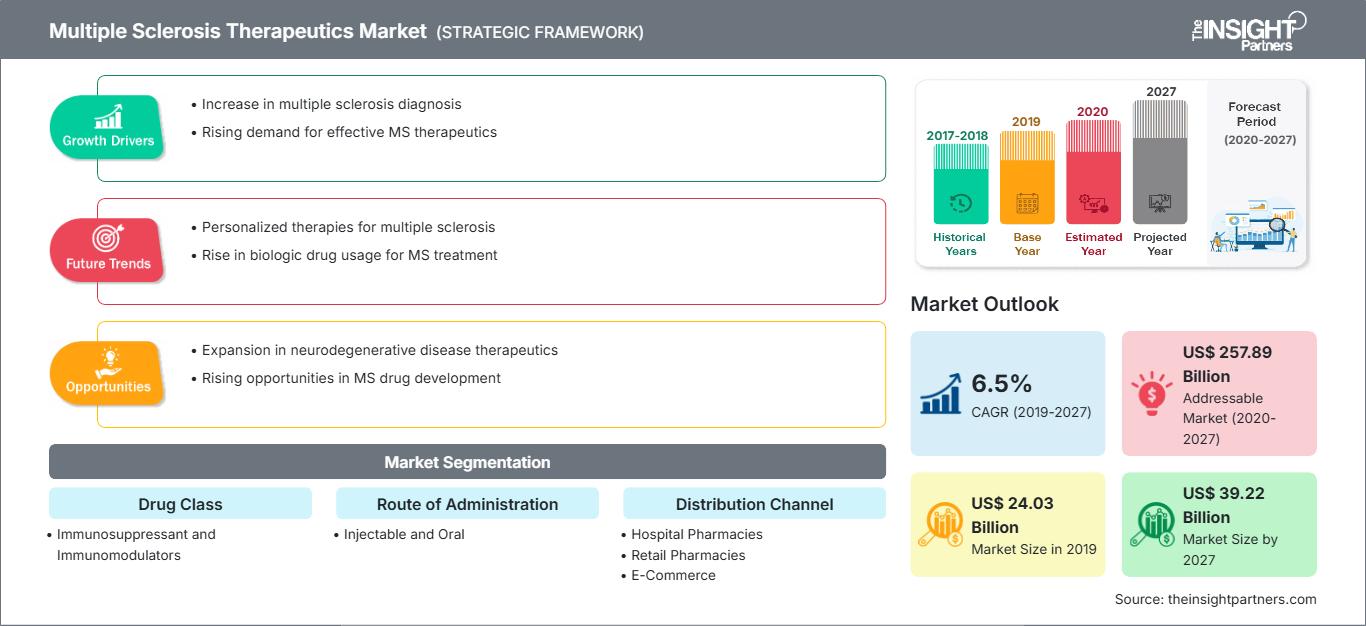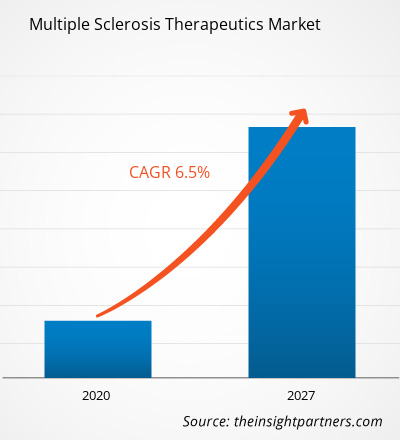2019 年多发性硬化症治疗市场价值为 240.269 亿美元,预计到 2027 年将达到 392.2359 亿美元;预计 2020 年至 2027 年的复合年增长率为 6.5%。
多发性硬化症 (MS) 是一种影响中枢神经系统的自身免疫性疾病。免疫系统攻击神经,导致大脑与身体其他部位之间的沟通障碍。免疫抑制剂和免疫调节剂以及物理疗法被广泛用于治疗 MS。
多发性硬化症治疗市场的范围包括药物类别、给药途径、分销渠道和地区。多发性硬化症治疗市场基于北美、欧洲、亚太地区、中东和非洲以及南美和中美洲等地区进行分析。该报告对多发性硬化症治疗市场提供了见解和深入分析,强调了各种参数,例如市场趋势、技术进步、市场动态以及全球主要市场参与者的竞争格局分析。
自定义此报告以满足您的要求
您将免费获得任何报告的定制,包括本报告的部分内容,或国家级分析、Excel 数据包,以及为初创企业和大学提供超值优惠和折扣
多发性硬化症治疗市场: 战略洞察

-
获取本报告的主要市场趋势。这个免费样本将包括数据分析,从市场趋势到估计和预测。
多发性硬化症是一种影响大脑、脊髓和视神经的慢性疾病。多发性硬化症的症状包括虚弱、焦虑、味觉异常、感觉减退以及视力模糊或视力丧失。其他一些症状包括便秘、肌肉僵硬、抑郁、思维问题和泌尿问题。
研究表明,全球多发性硬化症的患病率正在上升。例如,根据美国国家多发性硬化症协会 2017 年的研究,美国约有 100 万成年人(高达 913,925 人)患有 MS。2010 年,该病的估计患病率为每 100,000 人中有 309 例,即有 727,344 名成年人患有 MS。此外,根据加拿大政府(2014-2015 年估计)的数据,超过 77,000 名加拿大人患有多发性硬化症,其中四分之三为女性。
此外,多发性硬化症协会估计,2018 年英国约有 110,000 人患有这种疾病。该协会还提到,女性患多发性硬化症的几率是男性的两倍多。每年诊断出的新患者数量也在增加;从 2017 年的 5,000 人增加到 2018 年的 6,700 人。
因此,多发性硬化症患病率的上升推动了多发性硬化症治疗市场的发展。
基于药物类别的见解
根据多发性硬化症治疗药物类别,多发性硬化症治疗市场细分为免疫抑制剂和免疫调节剂。 2019年,免疫调节剂领域占据了更大的市场份额。该领域的增长归因于新仿制药的推出以及免疫调节剂在多发性硬化症治疗中的应用增加。预测期内,免疫抑制剂领域的复合年增长率可能会更高。
基于给药途径的洞察
就给药途径而言,多发性硬化症治疗市场分为注射剂和口服剂。2019年,注射剂领域占据了更大的市场份额,预计同一领域在预测期内的复合年增长率将更高。
基于分销渠道的洞察
根据分销渠道,多发性硬化症治疗市场细分为医院药房、零售药房和电子商务。 2019 年,医院药房占据了最大的市场份额,而电子商务领域预计在预测期内将在市场上实现最高的复合年增长率。
COVID-19 大流行已成为全球最严峻的挑战。这一挑战尤其对全球发展中国家而言是可怕的,因为它将导致全球贸易中断导致进口减少。迄今为止,尚未找到针对 COVID 19 的明确治疗方法。患有神经系统疾病等严重疾病的患者正在经历此类慢性疾病治疗的延误。与此次大流行相关的供应链中断最终将在短期内影响产品的销售。然而,由于药房在封锁期间获准营业,因此在大流行期间,多发性硬化症药物的供应一直很稳定。为应对 COVID-19 大流行,一些公司正在削减临床试验活动并推迟产品上市。例如,由于 COVID-19 疫情爆发,百时美施贵宝推迟了其多发性硬化症药物 Zeposia (ozanimod) 的上市。
产品发布和扩张策略通常被公司采用,以扩大其全球业务范围并满足不断增长的需求。市场参与者通常采用这些策略来扩展其产品组合。
在多发性硬化症治疗市场运营的市场参与者采用了产品创新策略来满足全球不断变化的客户需求,这也使参与者能够在全球范围内维护其品牌名称。
多发性硬化症治疗市场区域洞察
The Insight Partners 的分析师已详尽阐述了预测期内影响多发性硬化症治疗市场的区域趋势和因素。本节还讨论了北美、欧洲、亚太地区、中东和非洲以及南美和中美洲的多发性硬化症治疗市场细分和地域分布。
多发性硬化症治疗市场报告范围
| 报告属性 | 细节 |
|---|---|
| 市场规模 2019 | US$ 24.03 Billion |
| 市场规模 2027 | US$ 39.22 Billion |
| 全球复合年增长率 (2019 - 2027) | 6.5% |
| 历史数据 | 2017-2018 |
| 预测期 | 2020-2027 |
| 涵盖的领域 |
By 药物类别
|
| 覆盖地区和国家 |
北美
|
| 市场领导者和主要公司简介 |
|
多发性硬化症治疗市场参与者密度:了解其对业务动态的影响
多发性硬化症治疗市场正在快速增长,这得益于终端用户需求的不断增长,而这些需求的驱动因素包括消费者偏好的演变、技术进步以及对产品益处的认知度的提升。随着需求的增长,企业正在扩展产品线,不断创新以满足消费者需求,并抓住新兴趋势,从而进一步推动市场增长。

- 获取 多发性硬化症治疗市场 主要参与者概述
- 免疫抑制剂
- 免疫调节剂
按给药途径
- 注射剂
- 口服
按分销渠道
- 医院药房
- 零售药房
- 电子商务
按地域
- 北美
- 美国
- 加拿大
- 墨西哥
- 欧洲
- 法国
- 德国
- 意大利
- 英国
- 西班牙
- 欧洲其他地区
- 亚太地区 (APAC)
- 中国
- 印度
- 南韩国
- 日本
- 澳大利亚
- 亚太其他地区
- 中东和非洲 (MEA)
- 南非
- 沙特阿拉伯
- 阿联酋
- 中东和非洲其他地区
- 南美洲 (SAM)
- 巴西
- 阿根廷
- 南美洲其他地区
公司简介
- 默克公司
- 诺华公司
- 拜耳公司
- 赛诺菲公司
- 百时美施贵宝公司
- Horizon Therapeutics plc.
- 梯瓦制药工业有限公司
- 武田制药有限公司
- F.霍夫曼拉罗什有限公司
- 百健(Biogen)
- 历史分析(2 年)、基准年、预测(7 年)及复合年增长率
- PEST和SWOT分析
- 市场规模、价值/数量 - 全球、区域、国家
- 行业和竞争格局
- Excel 数据集
近期报告
客户评价
购买理由
- 明智的决策
- 了解市场动态
- 竞争分析
- 客户洞察
- 市场预测
- 风险规避
- 战略规划
- 投资论证
- 识别新兴市场
- 优化营销策略
- 提升运营效率
- 顺应监管趋势






















 获取免费样品 - 多发性硬化症治疗市场
获取免费样品 - 多发性硬化症治疗市场